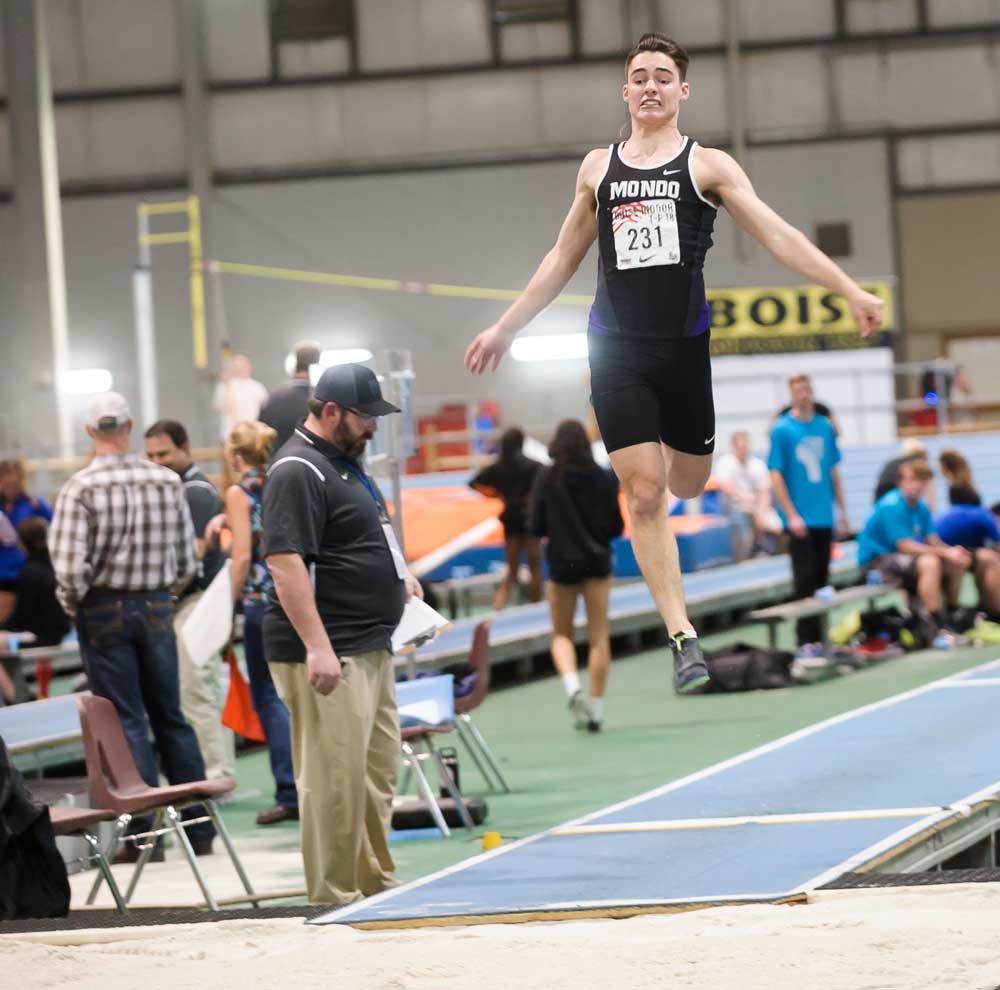The best time to start preseason is during the offseason
Published 12:00 am Tuesday, March 13, 2018

- Summit High senior Ryan Tennant is one of many Central Oregon athletes who took advantage of the indoor track and field season over the winter. At last month's Nike Boise Indoor in Idaho, for example, Tennant placed first in both the boys long and triple jumps and qualified for the national championships in North Carolina.(Submitted photo)
The first high school track and field meets of the year — “icebreaker” meets, intended to ease athletes into the new season — take place this week.
But for athletes like Bend High senior Raymond Blasquez and coaches like Redmond High’s Tim Conley, the season kicked off months ago. Track and field’s “offseason” is more of a preseason for those types. As a result, many Central Oregon athletes head into those icebreakers hot.
Trending
The OSAA does not sanction indoor track and field, meaning that athletes who wish to participate must do so “unattached” from his or her high school without wearing school colors. In Central Oregon, that opportunity is jumped upon.
“The problem with track season is it’s really short, from the first day OSAA allows us to practice until the state meet — 10 or 11 weeks — so the importance of having a strong base before that is really important,” says Conley, Redmond’s fifth-year boys coach. “The kids who are doing indoor track, especially the distance runners, are gaining that big base. And the rest of them are able to do a lot of work in the weight room and gaining extra strength and conditioning as well.”
Since the OSAA expanded to six classifications prior to the 2006-07 school year, Central Oregon high schools have produced 16 boys and girls team state champions in track and field and four runners-up. In 2007, area programs turned out seven individual champs. Last year, there were an all-time-high 26 state winners. Certainly a number of factors have gone into cultivating such track and field success. At least in recent years, perhaps pre-eminent among those factors is indoor track.
“Some schools don’t believe in indoor track at all,” says 17th-year Summit coach Dave Turnbull, whose girls program has won a state-record 11 straight team state titles. “Years ago, there were coaches that said, ‘We don’t understand why you do that. We don’t see a real benefit to having those kids do indoor track.’ My answer’s always been, ‘If you follow the science and train them in microcycles and develop those muscle fibers, the explosive power and all that stuff, it’s a definite advantage.’”
Local athletes cannot represent their high schools during the official track and field offseason, but there are several area clubs with which they compete. Mondo Track Club is composed mostly of Summit High athletes, Central Oregon Track Club is made up of competitors from the city of Bend, and the Redmond Raiders feature athletes from Redmond.
“Most successful running programs — high school, college, whatever — they’ve got their cross-country season right into their indoor (track) season,” says Kyle Will, Bend High’s sixth-year coach. “And most of the time, they use their indoor season to prime and get themselves ready for outdoor. They’re not trying to be at their best during indoor, but they certainly use it to get ready and use it as a tool.”
Trending
For several programs in Central Oregon, the winter track season begins in December. Weight lifting and drills to hone explosiveness and speed fill the few weeks spent indoors (except for this winter, one of the more mild in recent memory). Clubs and athletes choose which indoor meets (there are some half-dozen noteworthy meets in the Northwest) to attend, if at all. This season, COTC participated in only one indoor meet — the Battle of the Northwest Indoor Championship last month in Pullman, Washington. Other than that, the indoor season was all about training. Even that time, however, was beneficial.
“It’s an amazing advantage, especially for distance athletes,” Will says. “It takes 26 weeks to build an aerobic base. If I have a 10-week track season, I can’t get a kid ready to be a good, true, endurance, aerobic athlete. Speed and power are a little bit different, but to build that speed and that aerobic base for an aerobic event is huge. I wish we had an indoor high school season. I wish OSAA would consider doing that, because it does make a huge, huge difference.”
Little technical and mechanical work is done during winter track and field. At Summit, for example, every athlete, no matter his or her event, follows a similar training regimen: explosive bursts in the hallways or gym, training in the weight room, and, weather permitting, extra workouts on hills or stairs outside. The same can be said for Redmond and Bend, which have universal programs for athletes but also feature event-specific workouts for runners, throwers, jumpers and vaulters.
“They’re coming in with a skill set that maybe they didn’t have,” Turnbull says of indoor athletes heading into the spring. He notes that each of Mondo’s training cycles lasts six weeks before starting another cycle. The process begins just before Christmas break and lasts through the district championships in May, allowing athletes to roll into and through the spring season seemingly without missing a beat.
Recently, Summit senior Ryan Tennant has leaped into the spotlight. A Class 5A state champion in the long jump and a third-place finisher in the triple jump last season, Tennant this winter recorded wins in each event at the Nike Boise Indoor in Idaho. His marks earned him spots at last week’s New Balance Nationals Indoor in North Carolina, where he placed 14th in a field of 24 athletes from around the country and 32nd of 38 in the triple. Turnbull uses Tennant as a prime example of the benefits of indoor track and field.
“I can guarantee,” the coach says, “without winter conditioning, Ryan Tennant would not be where he’s at right now.”
Conley has his own go-to example. At the Class 5A state meet in 2016, Jacoby McNamara won the 100- and 200-meter dashes and, along with Donnie Pate, was a member of the winning 400 and 1,600 relay teams. Paced by that duo, Redmond High placed third at the boys 5A state meet for the program’s best finish at state since 1956. Those two runners, Conley says, were winter track and field die-hards.
“They came in as freshmen as OK sprinters,” the Panthers coach says. “But working really hard and doing the offseason weight training, they went out as some of the best in the state. … By the time they were seniors, after doing that for four years and doing four cycles of that, they were pretty tough to beat.”
For current Central Oregon high school athletes, indoor track has already paid dividends. Conley’s son, Redmond senior Treyson Conley, has been a winter track participant since his freshman year. Between his freshman and sophomore seasons, Treyson lopped 1 minute, 7 seconds off his 3,000 time, and he trimmed another four seconds between his sophomore and junior years.
“It’s really impacted my performance,” says Treyson, who was seventh in the boys 2-mile run last month at the Nike Boise Indoor. “Since then, I’ve been able to keep my fitness and not lose it between cross-country and track. … It shows where you’re at and what your training has been doing for you over the winter. You have kind of a payoff rather than having to train all winter without having any competition.”
Blasquez, the Bend High senior who tied for sixth in the high jump at state last season, is sold on the indoor season.
“All the kids who have done it or have been doing it,” he says, “it’s definitely going to show that they’ve been working so hard in the preseason.”
Winter track and field is all about working on general strength and explosiveness, says Will, Bend’s coach, “so when we start (the spring season) they’re strong and powerful and ready to go. … A lot of the things we want to have done when we really get going in outdoor, we take advantage of that time (in the winter) to allow them to hit the ground running, so to speak.”
According to Turnbull, Central Oregon athletes are already doing just that.
“We look to be in midseason shape right now,” Turnbull says, “and I bet all the other track programs feel the same way if their kids have been out there.”
—Reporter: 541-383-0307, glucas@bendbulletin.com.








